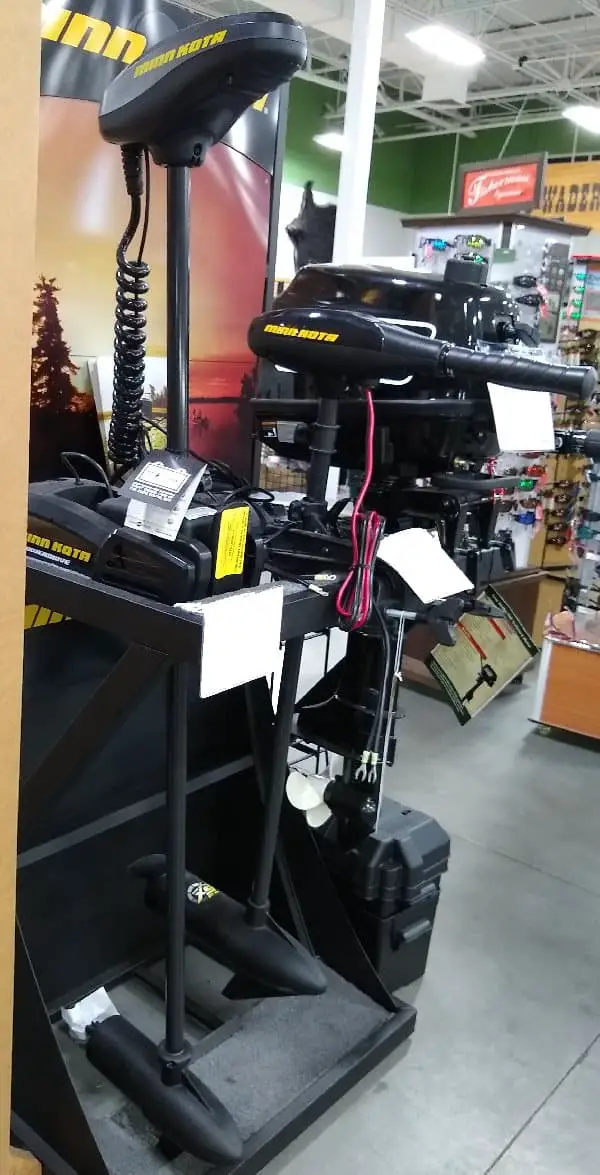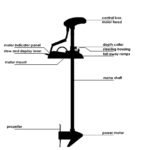There are a few key advantages to using a bow mount trolling motor over a transom mount starting with the bow mount motor’s ability to pull you in a straight line in adverse conditions like a high wind. Another major advantage to a bow-mounted trolling motor is quick directional response such as when holding position in a shallow water fishing environment you are able to spin the boat to the left or right instantly.
If you are not sure of the different types of electric trolling motors you can check out this article for a detailed description.
What are some advantages to bow mount trolling motors?
Let’s go into detail about a few of the features that make a bow-mounted trolling motor so great. The position at the very front of your boat allows the motor to pull your boat in any direction. When you mount your motor as close to the centerline as possible, your boat naturally wants to track in a straight line. With a simple push of a button, you can spin your boat left or right almost instantly.
If you have a GPS enabled motor as I have on my boat, you can turn on the autopilot, and your boat will virtually go in a straight line. Another feature of the GPS is spot lock aka anchor, I push a button on my remote, and my boat will hover in position. I find this feature works best with a slow current or light wind to provide a little backward pressure for the trolling motor to fight against.
The available options on bow mount electric trolling motors seem endless. Many GPS enable trolling motors can connect to your depth finder, providing they are compatible. On my Humminbird GPS, I can select a location or create a series of waypoints, and my motor will navigate to that location or a series of waypoints.
Here are two examples of how you would use some of these features in everyday fishing. Let’s say you are fishing in structure for bass. There’s a large number of downed trees and debris extending into the water, and you would like to stay relatively close to them but not disturb the water in any major way. You position your boat 20 feet away from this structure and start casting into it, but you do not get a bite.
You’re able to slowly move your boat in a straight line while fishing on autopilot. Some people use a foot control for this, which is very common in the bass world, I use a remote control hanging around my neck on a lanyard. You can combine these two devices so you can get quick responses from your foot control and detailed adjustments from your remote.
The next scenario will cover the same spot. You caught a few fish on your last pass, and you’d like to go back over the same spots, maybe a few feet closer. You can turn your trolling motor to one side, give it a short burst and spin your boat completely 180° around. That control is one of the advantages of the bow mount trolling motor. You would certainly move out of position 20 or 30 ft with a transom mount motor. Another option could be to use a backtrack feature on your depth finder your boat will automatically spin around and retrace your steps on auto-pilot until it reaches the beginning of your path or you cancel it.
Can I put a transducer on my bow mount trolling motor?
It can be very easy to attach a transducer to my bow mount trolling motor. There can be wires that hang down into the water but if you handle with care and a few zip ties and you are good to go. You should expect to see transducers built into the bottom of your trolling motors shortly which would eliminate all the wires running out the motor shaft. Many trolling motor models are starting to have transducer options available.
A bow-mounted trolling motor can be a great location for active scan sonar. Normally these transducers are larger and must be removed from the water when the boat is at cruising speed. Since these transducers need to be removed from the water, mounting them on a retractable device or a trolling motor is the only way to install them. The transducer I purchased included a mounting kit with two options to attach it to my trolling motor. Many manufacturers are embracing the active sonar platform so you can watch the fish as they move around the boat. Having this kind of active sonar in the lake and shallow structure areas can be a huge asset.
Can I remove my bow mounted trolling motor?
A feature to consider as an advantage is a removable bracket and plug for your trolling motor. When you initially install your trolling motor if you install it on a removable bracket and power plug you will be able to easily unplug your trolling motor from your boat and remove it if you are going to be fishing in an environment where you do not need your motor.
An example of this would be if you are fishing on the Columbia River for sturgeon, you will only be anchoring and not need your trolling motor. When you take your boat in for routine service by removing your trolling motor and any accessories on your boat, you will reduce the chance of people browsing through your boat for easy theft opportunities.
Can the weight of a bow mount trolling motor on the front of my boat a problem?
Bow mount trolling motors themselves, do not weigh very much, my motor, including the mounting assembly, weighs just over 65 pounds.
On very small boats they can make the boat a little front heavy, but with proper positioning of equipment in your boat it should balance out quite easily. Normally the heaviest part of your trolling motor system will be your batteries. If you have a very small boat like a 12-foot aluminum lake boat and put your batteries right in the center of your boat, then consider your other equipment like your main motor and gas tank you will have a good balance.
Two things to consider about a bow-mounted electric trolling motor on a small boat would be mounting options and how would you deploy the motor. So, you might need to create a special mounting bracket/bridge and use an auto-deploy motor, so you do not have to get into the front of the boat. Some motors have completely automatic deploy systems like the Ultrex or a pull cord deployment system which might also be a good option.
Average to larger boats can still be affected by the weight of your trolling motor. My boat is a 19-foot aluminum boat, and after I installed my electric trolling motor system, I could feel the ride performance difference. The ride was rougher and felt like the boat was crashing into the waves more, just like an extra person without a fishing pole.
What are the downsides to a bow mount trolling motor?
There are a few downsides to bow mount trolling motors starting with the overall cost can be significantly higher. A full system for a medium-size boat can run over $4000, click here to read my article.
As I mentioned in the last section, weight can be a real issue in small to medium size boats. The weight of batteries can add up fast, in my boat I am running 300 pounds in batteries for the trolling motor.
Your electric trolling motor sits in some valuable real estate right on the front of your boat. Many people enter and exit their boat from the front on smaller lakes. The spot where the motor is mounted is right where I like to put my knee when I enter the front of my boat. Using your anchor system can be a challenge when your motor is stowed across the open section of the bow. I find myself straddling my motor, so I can keep my balance while dropping my anchor.
Are there situations where a transom mount trolling motor would be better for my boat?
Most boats will have a transom mount gas trolling motor, so you will not need an additional motor on the back of your boat. If you wanted to go with an electric trolling motor on the back of your boat, there are some advantages.
Cost is a big one, the price of a small transom mount electric trolling motor, and two flooded-acid batteries could put you under $400 total, you can’t beat that.
Emissions of small gas motors in the past were so bad that I have seen people get sick from engine exhaust. Nowadays a newer gas motor will most likely be a four-stroke, and they burn very clean but are now cheap to buy.
Fuel is like trading six for a half dozen, sure you don’t use gas, but you have batteries that you charge by plugging them in at home. I am just not sure how much it costs to run my electric motor in electrical usage, but when I go to the campground, it is free, lol.
Slower troll speeds can make or break your day when fishing for lake trout. I only know a few ways to slow a gas motor down past the lowest speed. You can tie on buckets or sea anchors; I am not a big fan of these solutions because beginning anglers tend to get their line and fish caught in the rope, bucket, or sea anchor.
On my first aluminum boat, all I had was a transom-mounted 35lb electric trolling motor and two batteries, it made for a relaxing day on the water, along with a slow trip back to the ramp.
Conclusion:
I will summarize the advantages of the two types of trolling motors for you and see what you think.
Advantages of bow mount motors:
- Boat control
- Quick response
- Available options: GPS, advanced navigation, transducers
Advantages of transom mount motors:
- Cost (biggest one)
- Space
- Weight
I think the advantages of bow mount electric trolling motors outweigh the advantages of transom-mounted motors. In high wind, most people cannot fish, but you will discover if you can find fair water conditions the wind will not stop your fishing day.



